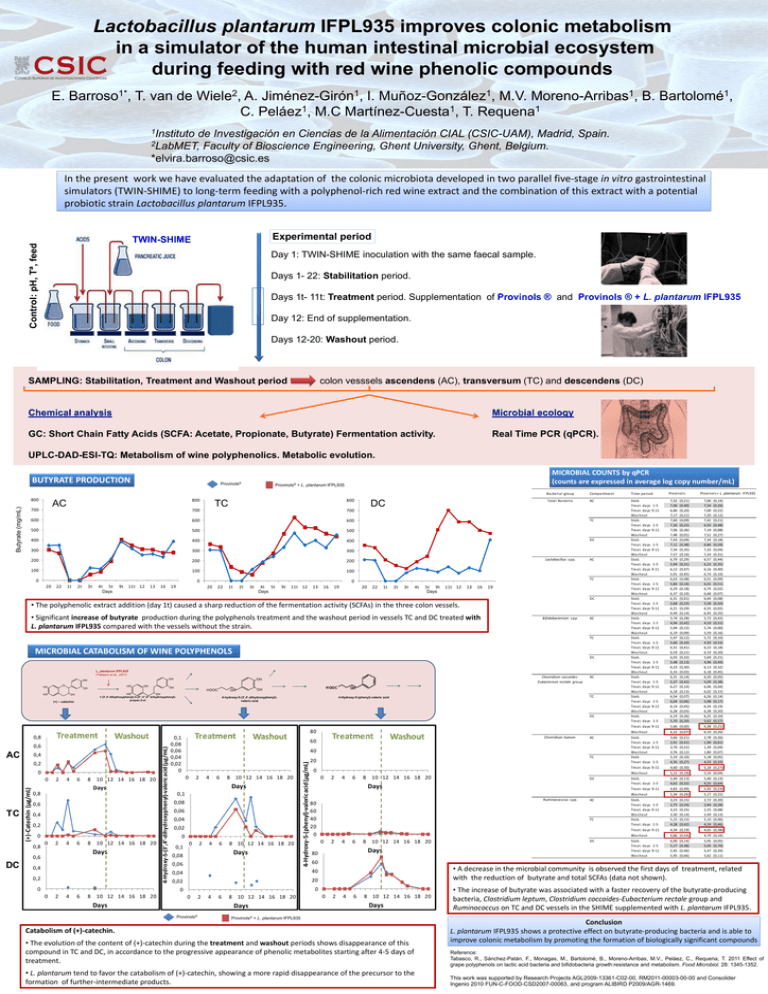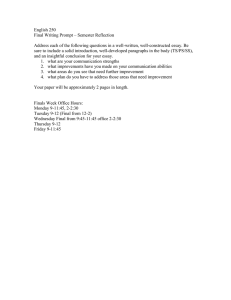IFPL935.ppt
advertisement

Lactobacillus plantarum IFPL935 improves colonic metabolism in a simulator of the human intestinal microbial ecosystem during feeding with red wine phenolic compounds E. Barroso1*, T. van de Wiele2, A. Jiménez-Girón1, I. Muñoz-González1, M.V. Moreno-Arribas1, B. Bartolomé1, 1 1 1 C. Peláez , M.C Martínez-Cuesta , T. Requena 1Instituto de Investigación en Ciencias de la Alimentación CIAL (CSIC-UAM), Madrid, Spain. 2LabMET, Faculty of Bioscience Engineering, Ghent University, Ghent, Belgium. *elvira.barroso@csic.es In the present work we have evaluated the adaptation of the colonic microbiota developed in two parallel five-stage in vitro gastrointestinal simulators (TWIN-SHIME) to long-term feeding with a polyphenol-rich red wine extract and the combination of this extract with a potential probiotic strain Lactobacillus plantarum IFPL935. Experimental period Control: pH, Tª, feed TWIN-SHIME Day 1: TWIN-SHIME inoculation with the same faecal sample. Days 1- 22: Stabilitation period. Days 1t- 11t: Treatment period. Supplementation of Provinols ® and Provinols ® + L. plantarum IFPL935 Day 12: End of supplementation. Days 12-20: Washout period. SAMPLING: Stabilitation, Treatment and Washout period colon vesssels ascendens (AC), transversum (TC) and descendens (DC) Chemical analysis Microbial ecology GC: Short Chain Fatty Acids (SCFA: Acetate, Propionate, Butyrate) Fermentation activity. Real Time PCR (qPCR). UPLC-DAD-ESI-TQ: Metabolism of wine polyphenolics. Metabolic evolution. BUTYRATE PRODUCTION Butyrate (mg/mL) 800 Provinols® 800 AC 700 600 Provinols® + L. plantarum IFPL935 800 TC 700 MICROBIAL COUNTS by qPCR (counts are expressed in average log copy number/mL) 500 500 400 Provinols + L. plantarum IFPL 935 400 400 300 AC Provinols 300 300 200 200 200 100 100 100 0 0 0 1t 2t 3t 4t 5t 9t 11t 12 13 16 19 Ti me peri od Tota l Ba cteri a AC Sta b. Trea t. da ys Trea t. da ys Wa s hout Sta b. Trea t. da ys Trea t. da ys Wa s hout Sta b. Trea t. da ys Trea t. da ys Wa s hout Sta b. Trea t. da ys Trea t. da ys Wa s hout Sta b. Trea t. da ys Trea t. da ys Wa s hout Sta b. Trea t. da ys Trea t. da ys Wa s hout Sta b. Trea t. da ys Trea t. da ys Wa s hout Sta b. Trea t. da ys Trea t. da ys Wa s hout Sta b. Trea t. da ys Trea t. da ys Wa s hout Sta b. Trea t. da ys Trea t. da ys Wa s hout Sta b. Trea t. da ys Trea t. da ys Wa s hout Sta b. Trea t. da ys Trea t. da ys 600 500 22 Compa rtment 700 600 20 DC Ba cteri a l group 20 22 1t 2t Days 3t 4t 5t 9t 11t 12 13 16 19 TC TC Provinols + L. plantarum IFPL 935 DC Provinols + L. plantarum IFPL 935 TC Provinols DC Provinols Lactobacillus s pp. DC AC TC 20 22 1t 2t 3t 4t Days 5t 9t 11t 12 13 16 19 Days DC • The polyphenolic extract addition (day 1t) caused a sharp reduction of the fermentation activity (SCFAs) in the three colon vessels. • Significant increase of butyrate production during the polyphenols treatment and the washout period in vessels TC and DC treated with L. plantarum IFPL935 compared with the vessels without the strain. Bifidobacterium s pp. AC TC MICROBIAL CATABOLISM OF WINE POLYPHENOLS DC L. plantarum IFPL935 (Tabasco et al., 2011) Clostridium coccoidesEubacterium rectale group 1-(3’,4’-dihydroxyphenyl)-3-(2’’,4’’,6’’-trihydroxyphenyl)propan-2-ol (+) – catechin 4-hydroxy-5-(3’,4’-dihydroxyphenyl)valeric acid AC TC 4-Hydroxy-5-(phenyl)-valeric acid DC 0,6 AC 0,4 0,2 0 TC (+)-Catechin (µg/mL) 0 2 4 6 8 10 12 14 16 18 20 Days 0,8 0,6 0,4 0,2 0 0,8 0 2 4 6 8 Days 0,6 DC 10 12 14 16 18 20 0,4 0,2 0 0 2 4 6 8 10 12 14 16 18 20 Treatment 0,1 0,08 0,06 0,04 0,02 0 Washout Treatment 60 Washout Clostridium leptum AC 40 0 2 4 6 8 10 12 14 16 18 20 Days 0,1 0,08 0,06 0,04 0,02 0 0,1 0 2 4 6 8 10 12 14 16 18 20 Days 0,08 0,06 4-Hydroxy-5-(phenyl)-valeric acid (µg/mL) Washout 4-Hydroxy-5-(3’,4’-dihydroxyphenyl)-valeric acid (µg/mL) Treatment 0,8 80 20 0 0 0 Days Days Provinols® 2 4 6 8 10 12 14 16 18 20 Days 60 0 8 10 12 14 16 18 20 8 10 12 14 16 18 20 DC AC TC 80 20 6 6 Ruminococccus s pp. 0 0,02 4 4 80 60 40 20 0 40 2 2 Days 0,04 0 TC DC Provi nol s Provi nol s + L. plantarum IFPL935 1-5 9-11 7,32 7,06 6,86 7,17 7,60 7,26 7,06 7,48 7,43 7,11 7,34 7,57 6,79 5,94 6,12 5,91 6,63 5,84 6,29 6,37 6,31 5,68 6,21 6,49 5,74 4,94 5,94 6,19 5,97 5,66 6,31 6,59 6,03 5,48 6,23 6,33 6,31 5,37 6,27 6,18 6,54 6,04 6,14 6,28 6,19 5,70 5,66 (0,21) (0,40) (0,20) (0,21) (0,09) (0,25) (0,36) (0,01) (0,09) (0,38) (0,35) (0,16) (0,29) (0,31) (0,47) (0,45) (0,08) (0,18) (0,18) (0,10) (0,01) (0,23) (0,29) (0,14) (0,28) (0,42) (0,15) (0,09) (0,12) (0,20) (0,41) (0,21) (0,32) (0,13) (0,30) (0,02) (0,14) (0,42) (0,10) (0,13) (0,07) (0,06) (0,45) (0,03) (0,26) (0,20) (0,60) 7,06 7,34 7,00 7,20 7,42 6,93 7,19 7,51 7,34 6,86 7,33 7,24 6,57 6,23 6,16 6,73 6,51 6,01 6,74 6,68 6,44 5,58 6,55 6,45 5,73 4,19 5,74 5,59 5,72 4,93 6,23 6,19 5,69 4,96 6,13 6,18 6,20 5,09 6,06 6,02 6,26 5,98 6,34 6,28 6,25 5,62 6,38 (0,14) (0,26) (0,22) (0,12) (0,21) (0,48) (0,08) (0,27) (0,18) (0,59) (0,04) (0,31) (0,44) (0,35) (0,40) (0,10) (0,09) (0,51) (0,02) (0,07) (0,08) (0,50) (0,02) (0,35) (0,42) (0,51) (0,00) (0,16) (0,10) (0,53) (0,18) (0,20) (0,21) (0,49) (0,32) (0,45) (0,05) (0,38) (0,04) (0,15) (0,14) (0,17) (0,19) (0,20) (0,10) (0,57) (0,21) Wa s hout Sta b. Trea t. da ys 1-5 Trea t. da ys 9-11 Wa s hout Sta b. Trea t. da ys 1-5 6,32 3,66 2,91 3,70 3,76 5,33 4,35 (0,07) (0,21) (0,41) (0,31) (0,12) (0,10) (0,27) 6,10 2,78 1,90 1,39 1,80 5,18 4,33 (0,26) (0,26) (0,61) (0,09) (0,07) (0,05) (0,33) Trea t. da ys 9-11 Wa s hout 4,60 (0,30) 5,15 (0,19) 5,18 (0,27) 5,16 (0,04) Sta b. Trea t. da ys 1-5 Trea t. da ys 9-11 5,40 (0,13) 4,62 (0,32) 4,83 (0,49) 5,40 (0,13) 4,55 (0,64) 5,43 (0,23) Wa s hout Sta b. Trea t. da ys 1-5 Trea t. da ys 9-11 Wa s hout Sta b. Trea t. da ys 1-5 5,34 3,23 2,75 3,23 3,30 5,15 4,28 5,17 2,72 2,84 2,25 2,49 5,10 4,24 Trea t. da ys 9-11 Wa s hout 4,34 (0,19) 4,86 (0,54) 4,65 (0,38) 4,79 (0,16) Sta b. Trea t. da ys 1-5 Trea t. da ys 9-11 Wa s hout 6,00 5,27 5,45 5,45 5,95 5,05 5,47 5,62 1-5 9-11 1-5 9-11 1-5 9-11 1-5 9-11 1-5 9-11 1-5 9-11 1-5 9-11 1-5 9-11 1-5 9-11 1-5 9-11 1-5 9-11 (0,26) (0,15) (0,24) (0,25) (0,14) (0,15) (0,42) (0,14) (0,38) (0,46) (0,66) (0,21) (0,20) (0,28) (0,08) (0,13) (0,06) (0,46) (0,05) (0,70) (0,39) (0,11) • A decrease in the microbial community is observed the first days of treatment, related with the reduction of butyrate and total SCFAs (data not shown). 0 2 4 6 8 10 12 14 16 18 20 Days Provinols® + L. plantarum IFPL935 Catabolism of (+)-catechin. • The evolution of the content of (+)-catechin during the treatment and washout periods shows disappearance of this compound in TC and DC, in accordance to the progressive appearance of phenolic metabolites starting after 4-5 days of treatment. • L. plantarum tend to favor the catabolism of (+)-catechin, showing a more rapid disappearance of the precursor to the formation of further-intermediate products. • The increase of butyrate was associated with a faster recovery of the butyrate-producing bacteria, Clostridium leptum, Clostridium coccoides-Eubacterium rectale group and Ruminococcus on TC and DC vessels in the SHIME supplemented with L. plantarum IFPL935. Conclusion L. plantarum IFPL935 shows a protective effect on butyrate-producing bacteria and is able to improve colonic metabolism by promoting the formation of biologically significant compounds Reference: Tabasco, R., Sánchez-Patán, F., Monagas, M., Bartolomé, B., Moreno-Arribas, M.V., Peláez, C., Requena, T. 2011 Effect of grape polyphenols on lactic acid bacteria and bifidobacteria growth:resistance and metabolism. Food Microbiol. 28: 1345-1352. This work was supported by Research Projects AGL2009-13361-C02-00, RM2011-00003-00-00 and Consolider Ingenio 2010 FUN-C-FOOD-CSD2007-00063, and program ALIBIRD P2009/AGR-1469.




